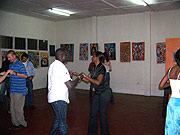An all together saucy kind of dance
Have you seen them move their hips? CHARLES KWIZERA discovers what the Salsa cultural music group are up to

Learning some new moves at Torero Cafu00e9 (Photo/C.Kwizera)
